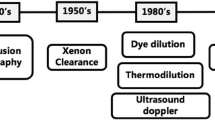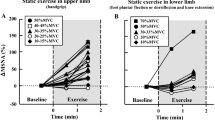Summary
Intramuscular pressure and muscle blood flow was measured in the supraspinatus muscle in 6 healthy subjects. The recordings were performed at rest, during isometric exercise, during an isometric muscle contraction of 5.6 kPa (42 mm Hg) and 10.4 kPa (78 mm Hg), and at rest after the contraction. Intramuscular pressure was measured by the microcapillary infusion technique, and muscle blood flow by the Xenon-133 washout technique. Intramuscular pressure was 38.2 kPa (SD 12.0) (287 mm Hg) during maximal voluntary contraction. A muscle contraction pressure of 5.6 kPa (42 mm Hg), which is 16% of maximal voluntary contraction, reduces local muscle blood flow significantly. It is concluded that the high intramuscular pressures found in supraspinatus during work with the arms elevated impedes local muscle blood flow.
Similar content being viewed by others
References
Ashton H (1975) The effect of increased tissue pressure on blood flow. Clin Orthop 113:15–26
Barcroft H, Millen JLE (1939) The blood flow through muscle during sustained contraction. J Physiol 97:17–31
Cerretelli P, Marconi P, Pendergast D, Meyer M, Heisler N, Piiper J (1984) Blood flow in exercising muscles by xenon clearance and by microsphere trapping. J Appl Physiol 56:24–30
Clayton JM, Hayes AC, Barnes RW (1977) Tissue pressure and perfusion in the compartment syndrome. J Surg Res 22:333–339
Edwards RTH (1988) Hypotheses of periferal and central mechanisms underlying occupational muscle pain and injury. Eur J Appl Physiol 57:275–281
Folkow B, Gaskell P, Waaler BA (1979) Blood flow through limb muscle during heavy rhythmic exercise. Acta Physiol Scand 80:61–72
Hagberg M (1981) Muscular endurance and surface electromyogram in isometric and dynamic exercise. J Appl Physiol 51:1–7
Henriksson KG (1988) Muscle pain in neuromuscular disorders and primary fibromyalgia. Eur J Appl Physiol 57:348–352
Herberts P, Kadefors R (1976) A study of painful shoulders in welders. Acta Orthop Scand 47:381–387
Herberts P, Kadefors R, Högfors C, Sigholm G (1984) Shoulder pain and heavy manual labour. Clin Orthop 191:166–178
Hill AV (1948) The pressure developed in muscle during contraction. J Physiol 107:518–526
Jonsson B (1978) Kinesiology- with special reference to electromyographic kinesiology. In: Cobb AW, Van Duijn H (eds) Contemporary clinical neurophysiology. EEG [Suppl 34] 417–428
Johnson MA, Polgar J, Weightman D, Appleton D (1973) Data on the distribution of fibre types in thirtysix human muscles. An autopsy study. J Neurol Sci 18:11–129
Järvholm U, Palmerud G, Styf J, Herberts P, Kadefors R (1988) Intramuscular pressure in the supraspinatus muscle. J Orthop Res 6:230–238
Jörgensen K, Fallentin N, Krogh-Lund C, Jensen B (1988) Electromyography and fatigue during prolonged, low level static contraction. Eur J Appl Physiol 57:316–321
Kadefors R, Petersén I, Herberts P (1976) Muscle reaction to welding work: An Electromyographic Investigation. Ergonomics 19:543–558
Kirkeboe A, Wisnes A (1982) Regional tissue fluid pressure in rat calf muscle during sustained contraction or stretch. Acta Physiol Scand 114:551–556
Körner L, Parker P, Almström C, Herberts K, Kadefors K (1984) The relation between spectral changes of the myoelectric signal and the intramuscular pressure of human skeletal muscle. Eur J Appl Physiol 52:202–206
Lassen NA, Lindbjerg J, Munch O (1964) Measurement of blood-flow through skeletal muscle by intramuscular injection of Xenon-133. Lancet 28:686–689
Matsen III FA (1975) Compartmental syndromes — a unified concept. Clin Orthop 113:8–14
Ogata K, Whiteside LA (1982) Effects of external compression on blood flow to muscle and skin. Clin Orthop 168:105–107
Pendergast DR, Krasney JA, Ellis A, McDonald B, Marconi C, Cerretelli P (1985) Cardiac output and muscle blood flow in exercising dogs. Respirat Physiol 61:317–326
Rathburn JB, MacNab J (1970) The microvascular pattern of the rotator cuff. J Bone Joint Surg 52-B:540–553
Sejerstedt OM, Hargens AR, Kardel KR, Blom P, Hermansen L (1984) Intramuscular fluid pressure during isometric contraction of human skeletal muscle. J Appl Physiol 56:287–295
Sejerstedt OM, Westgaard RH (1988) Occupational muscle pain and injury; scientific challenge. Eur J Appl Physiol 57:271–274
Sheridan GW, Matsen III FA (1975) An animal model of the compartmental syndrome. Clin Orthop 113:36–42
Sigholm G, Herberts P, Almström C, Kadefors R (1984) Electromyographic analysis of shoulder muscle load. J Orthop Res 1:379–386
Sjögaard G, Savard G, Juel C (1988) Muscle blood flow during isometric activity and its relation to muscle fatigue Eur J Appl Physiol 57:327–335
Styf JR, Körner LM (1986) Microcapillary infusion technique for measurement of intramuscular pressure during exercise. Clin Orthop 207:253–262
Styf J, Körner L, Suurkula M (1987) Intramuscular pressure and muscle blood flow during exercise in chronic compartment syndrome. J Bone Joint Surg 69-B:301–305
Tönnesen KH (1964) Blood flow through muscle during rhythmic contraction measured by Xe 133. Scand J Clin Lab Invest 16:646–654
Völlestad NK, Sejerstedt OM (1988) Biochemical correlates of fatigue. A brief review. Eur J Appl Physiol 57:336–347
Author information
Authors and Affiliations
Rights and permissions
About this article
Cite this article
Järvholm, U., Styf, J., Suurkula, M. et al. Intramuscular pressure and muscle blood flow in supraspinatus. Europ. J. Appl. Physiol. 58, 219–224 (1988). https://doi.org/10.1007/BF00417252
Accepted:
Issue Date:
DOI: https://doi.org/10.1007/BF00417252




